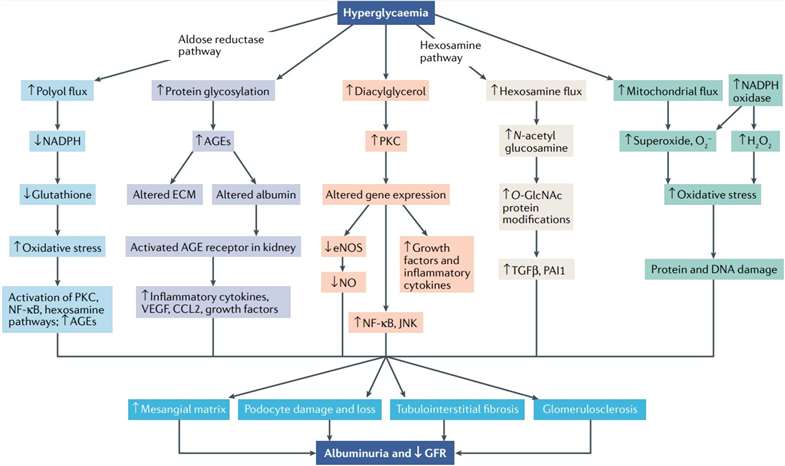Diabetic Nephropathy (DN) Models
Creative Bioarray provides in vivo pharmacodynamics studies in validated, well-established animal models of diabetic nephropathy (DN), which is useful in the rapid evaluation of a test compound's efficacy. According to your unique requirements, our scientists will partner with you to assist you from initial study design to final reporting and analysis of your data to provide you with reliable, reproducible results.
DN is the leading cause of kidney failure worldwide; in the USA, it accounts for over 50% of individuals entering dialysis or transplant programs. Unlike other complications of diabetes, the prevalence of diabetic kidney disease has failed to decline over the past 30 years. Hyperglycaemia is the primary aetiological factor responsible for the development of DN. Once hyperglycaemia becomes established, multiple pathophysiological disturbances, including glomerulosclerosis, mesangial expansion, podocyte loss and tubulointerstitial damage. The clinical manifestation of these effects is a progressive decline in kidney function, accompanied by macroalbuminuria.
 Fig. 1 Effect of hyperglycaemia on the kidney. (DeFronzo et al. 2021)
Fig. 1 Effect of hyperglycaemia on the kidney. (DeFronzo et al. 2021)
Our Animal Models of Diabetic Nephropathy
- Nephrectomy/Streptozotocin (STZ)/High Fat Diet-Induced Diabetic Nephropathy (DN) Model
- Spontaneous Diabetic Nephropathy Model
Quotation and Ordering
Backed by a team of seasoned experts and equipped with a wealth of technical expertise, Creative Bioarray takes pride in providing an extensive array of services tailored to pharmacology and pharmacodynamic studies. Our commitment to excellence ensures that we offer the most comprehensive solutions in the industry, catering to the diverse needs of our clients. If you are interested in our services, please feel free to contact us at any time or submit an inquiry to us directly.
Reference
- DeFronzo, R.A., et al. Pathophysiology of diabetic kidney disease: impact of SGLT2 inhibitors. Nature Reviews Nephrology, 2021, 17(5): 319-334.
For research use only. Not for any other purpose.
Disease Models
- Oncology Models
-
Inflammation & Autoimmune Disease Models
- Rheumatoid Arthritis Models
- Glomerulonephritis Models
- Multiple Sclerosis (MS) Models
- Ocular Inflammation Models
- Sjögren's Syndrome Model
- LPS-induced Acute Lung Injury Model
- Peritonitis Models
- Passive Cutaneous Anaphylaxis Model
- Delayed-Type Hypersensitivity (DTH) Models
- Inflammatory Bowel Disease Models
- Systemic Lupus Erythematosus Animal Models
- Oral Mucositis Model
- Asthma Model
- Sepsis Model
- Psoriasis Model
- Atopic Dermatitis (AD) Model
- Scleroderma Model
- Gouty Arthritis Model
- Carrageenan-Induced Air Pouch Synovitis Model
- Carrageenan-Induced Paw Edema Model
- Experimental Autoimmune Myasthenia Gravis (EAMG) Model
- Graft-versus-host Disease (GvHD) Models
-
Cardiovascular Disease Models
- Surgical Models
- Animal Models of Hypertension
- Venous Thrombosis Model
- Atherosclerosis model
- Cardiac Arrhythmia Model
- Hyperlipoidemia Model
- Doxorubicin-induced Heart Failure Model
- Isoproterenol-induced Heart Failure Model
- Arterial Thrombosis Model
- Pulmonary Arterial Hypertension (PAH) Models
- Heart Failure with Preserved Ejection Fraction (HFpEF) Model
-
Neurological Disease Models
- Alzheimer's Disease Modeling and Assays
- Seizure Models
- Parkinson's Disease Models
- Ischemic Stroke Models
- Acute Spinal Cord Injury (ASCI) Model
- Traumatic Brain Injury (TBI) Model
- Hypoxic-Ischemic Encephalopathy (HIE) Model
- Tourette Syndrome (TS) Model
- Amyotrophic Lateral Sclerosis (ALS) Model
- Huntington's Disease (HD) Model
- Intracerebral hemorrhage (ICH) Models
- Schizophrenia Model
- Pain Models
-
Metabolic Disease Models
- Type 1 Diabetes Mellitus Model
- Type 2 Diabetes Mellitus Model
- Animal Model of Hyperuricemia
-
Nonalcoholic Fatty Liver Disease Model
- High-Fat Diet-Induced Nonalcoholic Fatty Liver Disease (NAFLD) Model
- Methionine and Choline Deficient (MCD) Diet-Induced Nonalcoholic Fatty Liver Disease (NAFLD) Model
- Gubra-Amylin NASH (GAN) Diet-Induced Nonalcoholic Fatty Liver Disease (NAFLD) Model
- Streptozotocin (STZ) Induced Nonalcoholic Fatty Liver Disease (NAFLD) Model
- High Fat Diet-Induced Obesity Model
- Diabetic Foot Ulcer (DFU) Model
- Liver Disease Models
- Rare Disease Models
- Respiratory Disease Models
- Digestive Disease Models
-
Urology Disease Models
- Cisplatin-induced Nephrotoxicity Model
- Unilateral Ureteral Obstruction Model
- 5/6 Nephrectomy Model
- Renal Ischemia-Reperfusion Injury (RIRI) Model
- Diabetic Nephropathy (DN) Models
- Passive Heymann Nephritis (PHN) Model
- Adenine-Induced Chronic Kidney Disease (CKD) Model
- Kidney Stone Model
- Doxorubicin-Induced Nephropathy Model
- Orthotopic Kidney Transplantation Model
- Orthopedic Disease Models
- Ocular Disease Models
- Skin Disease Models
- Infectious Disease Models
- Otology Disease Models